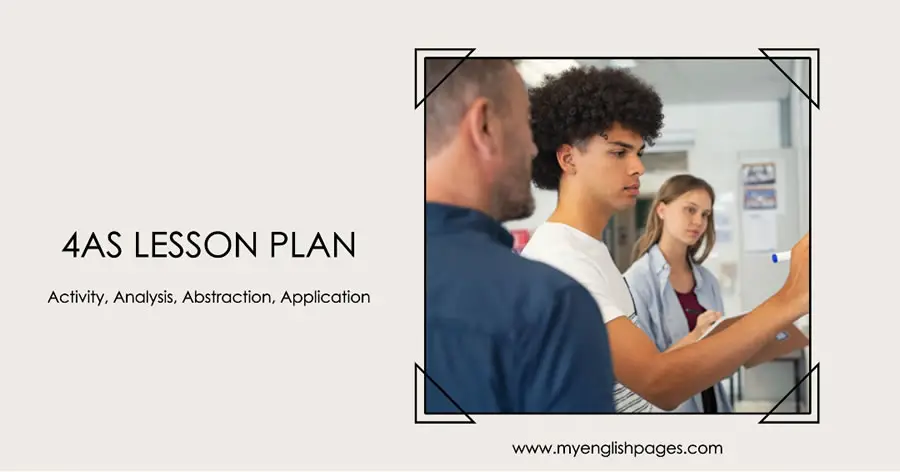This article provides a comprehensive overview of the 4as lesson plan. If you are interested in other approaches and methods of language teaching, follow these links:
Table of Contents
Introduction:
As teachers, we strive to create meaningful and creative learning experiences that actively engage our students. In this blog, we have covered so many teaching methods and learning theories that inform teaching. This article will focus on a particular model: the 4As framework, which fosters collaboration between students and teachers, making the learning process more student-centered.
Based on Kolb’s Experiential Learning Theory, this framework aims to approach students holistically, acknowledging their past experiences and integrating them into new learning contexts.
Let’s delve deeper into the 4A’s format and explore its potential for facilitating a deeper understanding of lessons.
What is the 4as lesson plan?
The 4A’s lesson plan is a framework widely used by teachers to design effective and student-centered lessons. The term “4As” stands for Activity, Analysis, Abstraction, and Application, representing the different stages of the lesson.
In the Activity phase, students engage with prior knowledge and participate in activities that spark their interest. The Analysis phase involves processing and classifying information, deepening their understanding of the topic. The Abstraction phase focuses on reinforcing and generalizing the lesson, allowing students to grasp the concepts in their own words. Finally, the Application phase brings practicality by encouraging students to apply what they have learned in real-life contexts.
The 4A’s lesson plan promotes active learning, critical thinking, and the practical application of language skills, fostering a comprehensive and engaging learning experience for students.

The 4As Lesson Plan and Experiential Learning Theory
The 4A’s framework is based on the Experiential Learning Theory proposed by David Kolb. Kolb’s theory suggests that learning occurs through a cycle of concrete experience, reflective observation, abstract conceptualization, and active experimentation. The 4A’s lesson plan aligns with this theory by incorporating activities, analysis, abstraction, and application to facilitate a holistic learning experience.
Brief Explanation of the 4A’s Format:

Here are the steps in a 4as lesson plan:
1. Activity:
The Activity phase serves as a foundation for student learning, building upon their existing knowledge while providing clarity on what they will learn. Through engaging activities, students gain a retrospective view of the topic and develop a sense of curiosity and interest. This phase lays the groundwork for a meaningful learning journey.
Example (Comparatives and Superlatives):
I. Activity:
- Begin the lesson by showing pictures of different objects and people to the students.
- Engage the students in a group discussion where they describe the pictures using adjectives, adverbs, etc. Encourage them to compare the objects or people based on size, height, age, etc.
2. Analysis:
The Analysis phase delves deeper into the lesson, encouraging students to process and classify information. Teachers transition from a lecturing role to that of a facilitator, guiding students through thought-provoking questions. By critically evaluating the validity of concepts, students gain a wider perspective while drawing closer to the main topic. This phase encourages students to think critically and refine their understanding.
Example (Comparatives and Superlatives):
II. Analysis:
- Provide examples of comparatives and superlatives and guide the students in constructing sentences using comparative and superlative forms.
- Ask the students to analyze the sentences and identify the rules and patterns for forming comparative and superlative forms.
- Facilitate a class discussion where students share their observations and findings.
- Pose questions to deepen their understanding, such as “What are the common suffixes used to form comparative and superlative forms?” or “How do irregular adjectives change when forming comparative and superlative forms?”
3. Abstraction:
In the Abstraction phase, teachers focus entirely on the lesson, reinforcing students’ existing knowledge while guiding them toward a deeper understanding. Through open-ended questions, teachers help students internalize the importance of the lesson and its relevance to their lives. By relating the content to real-world scenarios, students develop a sense of ownership and appreciation for the subject matter.
Example (Comparatives and Superlatives):
III. Abstraction:
- Guide the students to abstract the lesson’s main points and concepts.
- Summarize the rules and patterns for forming comparative and superlative forms, emphasizing the importance of using them accurately and appropriately in English.
- Encourage students to think about real-life situations where they can apply these language structures effectively.
4. Application:
The Application phase prompts students to apply their learning in practical ways. By considering how they can utilize their newfound knowledge, students explore innovative ways to improve and expand upon what they have learned. This phase encourages creativity, problem-solving, and the transfer of knowledge to real-life situations.
Example (Comparatives and Superlatives):
IV. Application:
- Provide practical tasks and activities where students can apply what they have learned. For example, they could write comparative and superlative sentences about their classmates or create a poster comparing different products or places.
- Engage students in discussions or role-plays where they use comparative and superlative forms to express opinions and preferences, or make comparisons.
- Encourage students to reflect on how they can incorporate these language structures into their everyday communication in English.
Role of the Teacher
To emphasize the effective implementation of the 4A’s framework, it is essential to facilitate rather than simply deliver the lesson. As teachers, we aim to guide students through each phase, allowing them to take ownership of their learning. It is crucial to strike a balance, ensuring students remain engaged without overwhelming them. Furthermore, mastery of the lesson by the teacher plays a vital role in creating a successful learning environment.

Comparing the 4as Framework with other Approaches
Let’s compare the 4A’s framework with three other commonly used approaches in English language teaching: the PPP (Presentation, Practice, Production) approach, task-based instruction, and discovery learning.
PPP Approach:
The PPP approach is a linear and teacher-centered method that follows a sequence of stages. It begins with the presentation of new language structures or vocabulary, followed by controlled practice activities, and ends with a production stage where students apply the language independently. The focus is on accuracy and mastery of specific language points.
Compared to the PPP approach, the 4A’s framework provides a more holistic and student-centered approach to lesson planning. It emphasizes active engagement, critical thinking, and practical application of language skills. The 4A’s framework encourages students to build on their prior knowledge, engage in analysis and abstraction, and apply the language in real-life contexts. It allows for more flexibility and creativity in designing lessons, promoting a deeper understanding of the language rather than solely focusing on accuracy.
Task-Based Instruction:
Task-based instruction shifts the focus from language forms to real-life communicative tasks. It involves designing meaningful tasks that simulate authentic communication situations, allowing students to use language creatively and problem-solve. The emphasis is on meaning and fluency rather than accuracy.
Compared to task-based instruction, the 4A’s framework incorporates elements of task-based learning within its application phase. The application phase encourages students to apply what they have learned in practical and meaningful ways, similar to task-based instruction. However, the 4A’s framework provides a more structured approach by incorporating activities, analysis, and abstraction before the application stage. It ensures that students have a solid foundation and understanding of the language before engaging in real-life tasks.
Discovery Learning:
Discovery learning is an inquiry-based approach where students actively explore and discover knowledge on their own through problem-solving and hands-on activities. The focus is on promoting critical thinking, curiosity, and independent learning.
Compared to discovery learning, the 4A’s framework combines elements of discovery and guided learning. While the activity and analysis phases of the 4As framework encourage students to explore and process information independently, the abstraction phase involves guided questioning and support from the teacher to reinforce understanding. The 4As lesson plan strikes a balance between providing structure and guidance while allowing for student exploration and discovery.
| Approach | Focus and Emphasis | Teacher’s Role | Student’s Role |
|---|---|---|---|
| 4A’s Framework | Holistic learning, practical application | Facilitator, guide | Active participant, thinker |
| PPP Approach | Accuracy, language mastery | Presenter, instructor | Practice activities, learner |
| Task-Based Instruction | Meaningful tasks, communicative skills | Facilitator, task designer | Communicator, problem-solver |
| Discovery Learning | Inquiry, independent exploration | Facilitator, resource provider, guide | Explorer, independent learner |
In summary, the 4as lesson plan offers a student-centered and holistic approach to lesson planning, promoting active engagement, critical thinking, and practical application of language skills. It incorporates elements of task-based instruction and discovery learning while providing a structured framework for teachers to guide students through different stages of the learning process.
Conclusion:
The 4As lesson plan provides English language teachers with a powerful tool to create student-centered learning experiences. By incorporating engaging activities, promoting critical analysis, fostering abstraction, and encouraging practical application, teachers can cultivate a deeper understanding of lessons.
It is through collaboration and facilitation that students truly thrive, unlocking their potential and achieving meaningful learning outcomes. Remember, the mastery of a lesson by the teacher enhances the overall learning experience and yields positive results. Try the 4As framework and embark on a journey of transformative teaching.
Here is an example of the 4as Lesson plan:
4as Lesson Plan Sample
Comparatives and Superlatives
4as lesson plan example
| Date: | Level: | Materials Needed: |
|---|---|---|
| [Date] | [Level] | Pictures of objects and people Paper, pencils Whiteboard and markers Posters or visual aids (optional) |
Class Information and Materials
Objectives:
- To introduce and practice the use of comparatives and superlatives in English.
- To develop students’ ability to compare and describe objects and people using comparative and superlative forms.
- To promote accuracy and appropriate use of comparative and superlative structures in communication.
Stages and Procedures:
| Stage | Mode of Work | Timing | Procedures |
|---|---|---|---|
| I. Activity | Group Discussion | 10 mins | 1. Show pictures and engage students in a group discussion. 2. Encourage students to describe the pictures using adjectives, adverbs, etc. and make comparisons. |
| II. Analysis | Individual, Pair, Group | 15 mins | 1. Provide examples of comparatives and superlatives. 2. Guide students in constructing sentences using comparative and superlative forms. 3. Ask students to analyze the sentences and identify the rules and patterns. 4. Facilitate a class discussion to share observations and findings. |
| III. Abstraction | Whole Class | 10 mins | 1. Guide students to abstract the main points and concepts. 2. Summarize the rules and patterns for forming comparative and superlative forms. 3. Emphasize the importance of accurate and appropriate use in English. |
| IV. Application | Pair, Group, Individual | 20 mins | 1. Provide practical tasks and activities for students to apply what they have learned. 2. Tasks may include writing comparative and superlative sentences, creating a poster, or engaging in discussions or role-plays. 3. Encourage students to reflect on real-life situations where they can use comparative and superlative forms effectively. |
Lesson Procedure
Closure:
- Conduct a brief wrap-up of the lesson, emphasizing the key concepts and language structures covered.
- Allow students to ask any remaining questions or seek clarification.
Homework/Extension:
- Assign relevant exercises or tasks for students to practice using comparatives and superlatives independently.
- Provide additional resources or materials for further exploration and practice.
Note: The timings provided are approximate and can be adjusted based on the class dynamics and pace of learning.


